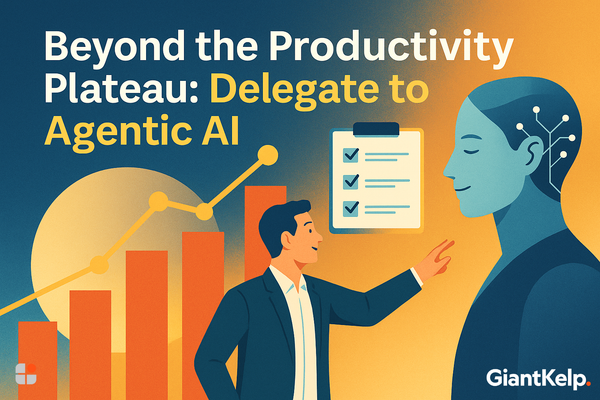Let's paint a picture...
You’ve been here before. You ask your AI to draft a proposal. It responds with twenty questions: What’s the format? What’s the tone? When’s it due? Helpful? Maybe. But still high effort on your part.
Now picture this instead. You assign the same task to an AI that already knows your structure, brand voice, and audience. It starts writing. It flags anything weird. It finishes.
That’s the difference between having help and handing something off. Between assistance and delegation.
Welcome to the Productivity Plateau.
That spot where your AI’s output isn’t getting better. You’re stuck in helper mode, hovering over every prompt like a helicopter parent. And returns are diminishing fast.
Wouldn't it be nicer to delegate once and get the same returns.
For this, you don’t need more AI power - you need Agentic AI.
Why the Plateau Happens
At first, AI feels like magic. You prompt, it responds, you save time.
But over time, a few things creep in. You start reusing the same prompts over and over. You’re still the one polishing most of the output. You find yourself hesitating to trust AI with anything meaningful. And, frustratingly, your calendar hasn’t changed at all.
This - where you are right now - is Assistant Mode - where AI collaborates but doesn’t own anything.
The solution? Transition to Delegate Mode using Agentic AI.
If you do it right - and GiantKelp can help with that, of course - you get the below...
Automating the Marketing Workflow
Before:
Your Head of Marketing, used GPT-4 to help brainstorm ideas and draft ad copy. Each campaign took ~8 hours across brainstorming, copywriting, and formatting.
After:
She built an Agent that:
- Pulled product updates from internal docs
- Created copy variants in brand voice
- Auto-filled campaign calendars
- Prepped everything for review
Time saved per campaign: 5+ hours
Bonus: More consistent tone, faster A/B tests
“Using AI agents for campaign generation reduced production time by 63% while improving message consistency” (Liu et al., 2023).
Streamlining Financial Reporting
Before:
A portfolio CFO, used ChatGPT to help clean spreadsheet formulas and summarise cash flow by hand each month.
After:
He built an agent pipeline that:
- Extracts raw financials
- Applies logic rules for formatting
- Summarises key risks
- Flags outliers and anomalies
Result: Reports are 90% ready before he opens his laptop.
“Structured delegation of financial summarisation improved accuracy and reduced analyst hours by over 40%” (McKinsey & Company, 2023).
Leveling Up Customer Support
Before:
You're running a small customer service team where AI helped draft responses manually, but you are still triaging all the tickets.
After:
You deployed an AI workflow that:
- Categorises incoming tickets
- Assigns priority
- Auto-replies for common issues
- Escalates edge cases to humans
Impact:
- Faster first responses
- Lower backlog
- Staff freed up for more complex, higher value issues
“Agentic triage systems can reduce ticket response time by 50–70%” (Yao et al., 2024).
The Difference: Delegation > Assistance
| Mode | Who Drives? | Trust Level | Output Consistency | Scalability |
|---|---|---|---|---|
| Assistant | You | Low | Medium | Low |
| Delegate | AI Agent | Higher | High | High |
Agentic AI doesn’t mean you leave it unsupervised.
It means you codify what "done right" looks like, so your AI can follow through without constant babysitting.
ROI-Math
| Scenario | Time Saved (hrs/mo) | Cost Saved (£/mo) | Uplift (%) |
| Marketing Campaigns | 20 | £2,000 | +60% |
| Financial Reporting | 15 | £1,500 | +45% |
| Customer Support Ops | 25 | £2,500 | +70% |
Assumes £100/hr blended rate; conservative uplift.
McKinsey estimates generative AI could automate work activities that absorb 60%–70% of employee time today, especially in knowledge roles (McKinsey & Company, 2023). Assuming a conservative 3 hours saved per weekly task at a £100/hour rate, the annual ROI could reach ~£15,600 per task.
So... How Do You Start?
- Choose one painful, repeatable task
Hint: Anything you say “Ugh, again?” about. - Break it down into clear steps
Inputs → Logic → Outputs - Create structured prompts or templates
No vague instructions. Think like a SOP. - Use agent orchestration
Tools like CrewAI or LangGraph help you string steps together. - Embed feedback loops
Ask: “What would I tell a junior if they messed this up?”
But Isn’t That Overkill?
It can feel like it - until it saves you 30+ hours a month.
Delegation doesn’t mean zero effort. It means front-loading intelligence so you get back compound value.
“Delegating with Agentic AI is like writing standard operating procedures once and having them executed 1,000 times with no drop in quality” (Liu et al., 2023).
Don’t Be the Bottleneck
If you’re still asking AI to help, you’re thinking too small.
Delegate the repeatable. Codify the steps. Let agents do the grind.
Then step back and say, “Thanks, team.”
Because your agents are a team - they just happen to run on silicon.
References
Liu, H., Chang, J., Agarwal, R., et al. (2023). AgentBench: Evaluating Foundation Models for Agentic Behavior. arXiv preprint arXiv:2308.11459.
McKinsey & Company. (2023). The Economic Potential of Generative AI: The Next Productivity Frontier. https://www.mckinsey.com/mgi/overview/in-the-news/the-economic-potential-of-generative-ai
Yao, S., Zhao, J., Yu, D., et al. (2024). Tree of Thoughts: Deliberate Problem Solving with Large Language Models. arXiv preprint arXiv:2305.10601.
